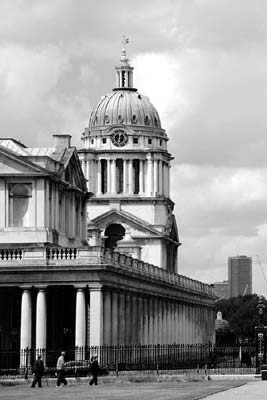
▲▲ Royal Observatory Greenwich
Still well within the city limits of London, the Royal Borough of Greenwich (GREN-ich)—England’s maritime capital—feels like a small town all its own. Visitors come here for all things salty, including the Cutty Sark clipper, the area’s premier attraction. Greenwich is synonymous with timekeeping and astronomy, and at the Royal Observatory Greenwich, you can learn how those pursuits relate to seafaring. Greenwich also has stately Baroque architecture, appealing markets, a fleet of nautical shops, plenty of parks, kid-friendly museums, and hordes of tourists. Since many of the major sights here are free to enter, and you can travel between central London and Greenwich on a cheap Tube ticket, it’s a wonderfully inexpensive day out. And where else can you set your watch with such accuracy?
Note that Greenwich pairs perfectly with a quick visit to the Docklands, London’s glittering skyscraper zone (just across the river from Greenwich, and covered in the next chapter).
It’s a joy by boat or a snap by Docklands Light Railway (DLR). I enjoy a mix-and-match approach: Ride the boat to Greenwich for the scenery and commentary, and take the DLR back—especially if you want to stop at the Docklands on the way home. On pleasant weekends, early evening London-bound boats fill up quickly as everyone leaves around the same time (17:00-18:00)—another reason to boat here and take the DLR back to central London.
By Boat: From central London, you can cruise scenically down the Thames to Greenwich. Various tour boats—with commentary and open-deck seating—leave from the piers at Westminster, Waterloo, and the Tower of London (2/hour, 30-75 minutes). Most boats have commentary only on the way to Greenwich, but if you really want it on the way back, you can ask the boat staff to provide it.
Thames Clippers offers faster trips, with no commentary and only a small deck at the stern (departs every 20-30 minutes from several piers in central London, 20-45 minutes). Thames Clippers also connects Greenwich to the Docklands’ Canary Wharf Pier (2-3/hour, 10 minutes).
For cruising details, see here .
By Docklands Light Railway (DLR): From the Bank-Monument Station in central London, take the DLR to Cutty Sark Station in central Greenwich; it’s one stop before the main—but less central—Greenwich Station (departs at least every 10 minutes, 20 minutes, all in Zone 2, covered by any Tube pass). The DLR works like the Tube; be sure to touch your card to the reader on the platform before and after your journey, or risk being fined.
Many DLR trains terminate at Canary Wharf, so make sure you get on one that continues to Lewisham or Greenwich. (If you do end up at Canary Wharf, you can catch a train to Greenwich’s Cutty Sark Station within a few minutes). Some DLR trains terminate at Island Gardens, where you can disembark and enjoy the unique experience of walking under the Thames into Greenwich: To reach the pedestrian tunnel, exit the station, cross the street, and follow signs to Island Gardens for a good photo op. Then enter the red-brick Greenwich Foot Tunnel (opened in 1902), descend 86 spiral stairs (or ride the lift), hold your breath, and re-emerge on dry land at the bow of the Cutty Sark.
By Bus: Catch bus #188 from Russell Square near the British Museum (about 45 minutes to Greenwich).
(See "Greenwich" map, here .)
When to Go: To allow enough time to see everything—and to fit in a Docklands visit on your way back—head to Greenwich in the morning. Some of the sights can get crowded with families and school groups, especially in summer and on weekends. You can save a little time by reserving your Cutty Sark visit in advance (explained on here ).
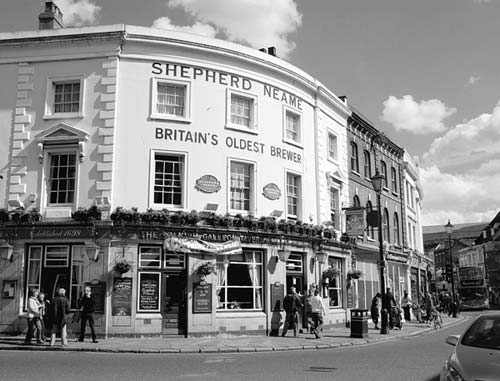
Opening Times: Greenwich’s main sights are open daily from 10:00 to 17:00; some stay open later (complete hours listed later for each individual sight). On Mondays, stalls at the town’s popular market are closed.
Information: The TI is within the Discover Greenwich visitors center, inside the Old Royal Naval College gates (daily 10:00-17:00, Pepys House, 2 Cutty Sark Gardens, tel. 0870-608-2000, www.visitgreenwich.org.uk ). For more on Discover Greenwich, see the listing later in this chapter.
Tours: Guided city walks, which depart from the TI within Discover Greenwich, offer an overview and go past most of the big sights (£8, daily at 12:15 and 14:15, 1.5 hours; the only sights you enter are the Painted Hall and Chapel of Sts. Peter and Paul, and only on the 14:15 tour; the 12:15 tour leaves you at the door of the Royal Observatory).
Services: Free WCs are located inside the Discover Greenwich visitors center. For eating recommendations, see the sidebar on here .
Markets: Thanks to its markets, Greenwich throbs with browsing Londoners on weekends. The Greenwich Market is an entertaining mini Covent Garden, located in the middle of the block between the Cutty Sark DLR station and the Old Royal Naval College—right on your way to the sights (farmers market, arts and crafts, and food stands; Tue-Sun 10:00-17:30, closed Mon; antiques on Tue, Thu, and Fri, www.greenwichmarketlondon.com ).
The Clocktower Market sells old odds and ends at high prices on Greenwich High Road, near the post office (Sat-Sun and bank holidays only 10:00-17:00, www.clocktowermarket.co.uk ).
Exploring Back Streets: Allow time to browse the town. Greenwich has two sides: prim and proper (east of Church Street) and lived-in local (west of Church Street). Wander beyond touristy Church Street and Greenwich High Road to where flower stands spill onto the side streets, antique shops sell brass nautical knickknacks, and salty pubs occupy more than just the corner. King William Walk, College Approach, and Nelson Road (all in the vicinity of Greenwich Market) are all worth a look.
Length of This Tour: Allow about two hours simply to stroll the area and enjoy the parks. Add several hours more to enter the sights (figure about an hour for the Cutty Sark, 30 minutes each for the Royal Naval College and the Queen’s House, and an hour or two apiece for the National Maritime Museum and the Royal Observatory).
Starring: Glorious parks and stately buildings, maritime history, and the prime meridian.
Tudor kings favored the palace at Greenwich. Henry VIII was born here. Later kings commissioned architects Inigo Jones and Christopher Wren to beautify the town and palace, and William and Mary built a grand hospital to care for retired seamen (which later became a college for training naval officers). Today, Greenwich is a pincushion of royal, maritime, and scientific sights from Britain’s illustrious past.
(See "Greenwich" map, here .)
I’ve linked Greenwich’s major sights with handy walking directions. Each attraction is described in full and rated; you can pick and choose which ones to enter. If you’re in a rush, make a beeline to the sights that interest you.
• Our first stop is the Cutty Sark. If you’re arriving by boat, it’s right in front of you. If you’re coming by DLR, you’ll get off at the Cutty Sark stop, exit the station to the left, pass under the brick archway, and turn left. The Cutty Sark is just ahead on the right.
The Scottish-built Cutty Sark was the last of the great China tea clippers and the queen of the seas when first launched in 1869. She was among the fastest clippers ever built, the culmination of centuries of ship design. With 32,000 square feet of sail—and favorable winds—she could travel 300 miles in a day. But as a new century dawned, steamers began to outmatch sailing ships for speed, and by the mid-1920s the Cutty Sark was the world’s last operating clipper ship. After a stint as a training ship, she was retired and turned into a museum in the 1950s.
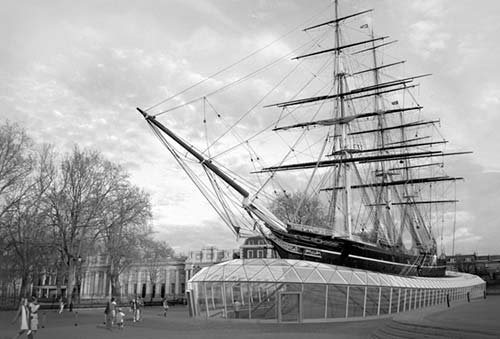
Following a five-year-long restoration, interrupted by a devastating fire, the ship reopened to the public in the spring of 2012. The spectacular new display space has one major drawback: The glass building obscures the elegant lines of the hull that gave the Cutty Sark her record-breaking speed (one critic groused that the ship now “looks like it has run aground in a giant greenhouse”). On the plus side, the building allows visitors to walk directly below the ship, which has been raised 11 feet above her dry dock. Above deck, the ship’s rigging has been restored to original specifications, while below deck, displays explore the Cutty Sark ’s 140-year history and the cargo she carried—everything from tea to wool to gunpowder—as she raced between London and ports all around the world.
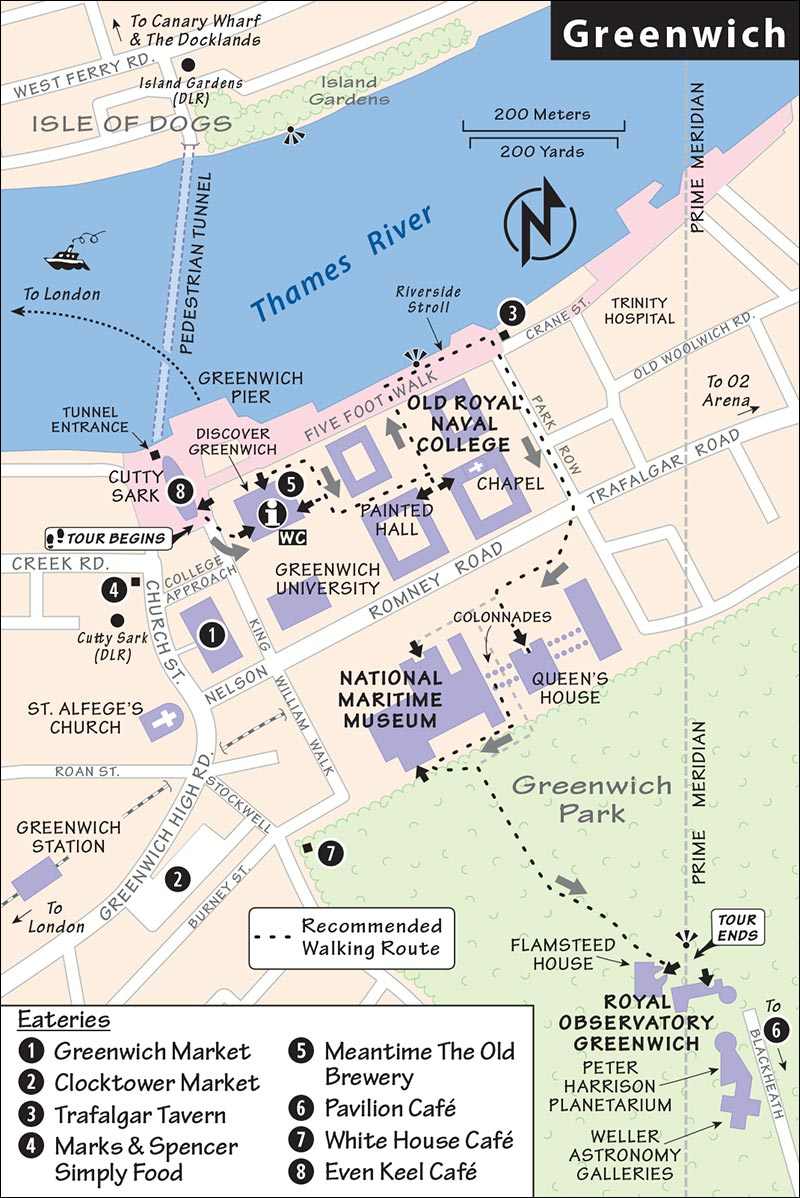
Cost and Hours: £13.50, kids ages 5-15-£7, free for kids under age 5, family tickets available, Day Explorer combo-ticket with Royal Observatory-£18.50, kids combo-ticket-£8.50; daily 10:00-17:00, may stay open until 18:00 during school holidays; last entry 45 minutes before closing; £5 guidebook available but hardly necessary, reservation tel. 020/8312-6608, www.rmg.co.uk .
Crowd-Beating Tips: The ship can get busy on school holidays and on weekends. To skip the ticket-purchasing line, you can reserve ahead online or by phone, or just try showing up around 13:00, when there’s often a lull in visitors.
Visiting the Cutty Sark: The first deck you’ll visit harkens back to the ship’s days in the Chinese tea trade...which didn’t last long, as the Suez Canal soon opened, allowing steam-powered ships to reach China much faster than sailboats. The Cutty Sark turned to trading wool with Australia, as explored on the next deck up. This “Tween Deck” is full of not-quite-gimmicky displays that mostly succeed in making the ship’s history come alive, even for adults. Find the fun video game that lets you attempt to beat Captain Woodget’s record voyage sailing a wool-laden Sark from Sydney to London. Sit on the tilting benches of tea crates for a seaborne feel, enjoy the oddly mesmerizing video at the stern, and get the figurehead’s take on Sark history in the bow.
Sailing fans will like the gorgeously restored top deck best. Notice how pathetic the crew’s mattresses were—then go check out the captain’s cabin. Don’t miss the video showing the rigger’s-eye-view as he climbs high above the deck. Your visit ends down below, where you can take a coffee break directly under the shiny hull (it may gleam like gold, but the hull’s covering is actually an alloy of copper and zinc). Videos describe how the mighty vessel was designed and then preserved. Near the bow is a colorful collection of figureheads from other ships. On the floor directly under the front of the hull, note the compass rose that shows how many days at sea it’d take to reach major ports from here.
• Leaving the museum, head left, and find the visitors center called...
While it’s hardly a museum, this center offers a decent introduction to Greenwich and some fun exhibits for kids. In the middle, a model of the town lights up to tell its history. Surrounding the model are displays and artifacts from various people who have left their mark on the town, along with exhibits about the architecture and construction of Greenwich’s fine buildings. Tours of the Royal Naval College leave from the reception desk. Adjoining Discover Greenwich are the TI, free WCs, and a recommended pub, Meantime The Old Brewery.
Cost and Hours: Free, daily 10:00-17:00, tel. 020/8269-4747, www.ornc.org .
• Leave through the far exits (away from the Cutty Sark), turn right at the brewery, and continue through the manicured park to the open quad, where dramatic identical-twin buildings make up the heart of the...
The college was originally a hospital founded by Queen Mary II and King William III in 1692 as a charity to care for retired or injured naval officers (called pensioners). William and Mary spared no expense, hiring the great Christopher Wren to design the complex (though other architects completed it). Its days as a hospital ended in 1869, and it served as a college for training naval officers from 1873 to 1998. Now that the Royal Navy has moved out, the public is invited to view the college’s elaborate Painted Hall and Chapel of Sts. Peter and Paul, which are in symmetrical buildings that face each other overlooking a broad riverfront park.
Cost and Hours: Free (£3 suggested donation), daily 10:00-17:00, sometimes closed for private events, service Sun at 11:00 in chapel—all are welcome, www.ornc.org .
Visiting the College: Each building sells a descriptive guide (50p-£1), or you can buy the fun Nasty Naval College brochure (made for children, but with entertaining offbeat facts about the place; £1). Volunteers are often standing by to answer questions. Visit the highlight—the Painted Hall—first, before touring the chapel.
Painted Hall: Originally intended as a dining hall for pensioners, this sumptuously painted room was deemed too glorious (and, in the winter, too cold) for that purpose. So almost as soon as it was completed, it became simply a place to impress visitors.
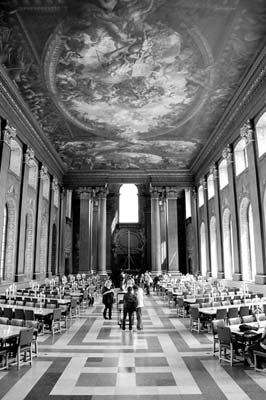
Enter the hall, climb the stairs, and gape up at one of the largest painted ceilings in Europe—112 feet long. It’s a big propaganda scene, glorifying the building’s founders, Queen Mary II and King William III (who, as a Protestant monarch, had recently trounced the Catholic French King Louis XIV in a pivotal battle). Crane your neck—or use the clever wheeled mirrors—to examine the scene. In the center are William and Mary. Under his foot, William is crushing a dark figure with a broken sword...Louis XIV. William is handing a red cap (representing liberty) to the woman on the right, who holds the reins of a white horse (symbolizing Europe). On the left, a white-robed woman hands him an olive branch, a sign of peace. The message: William has granted Europe liberty by saving it from the tyranny of Louis XIV. Below the royal couple, the Spirit of Architecture shows them the plans for this very building (commemorating the sad fact that Mary died before its completion). Ringing the central image are the four seasons (represented by Zodiac signs), the four virtues, and—at the top and bottom—a captured Spanish galleon and a British man-of-war battleship.
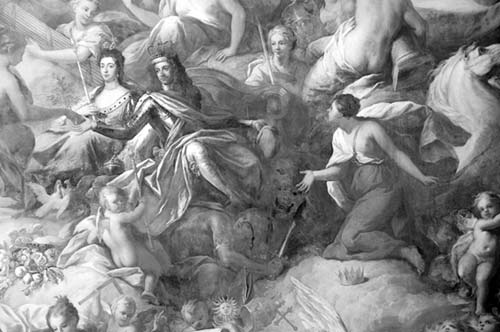
Up the steps at the end of the room, along the wall of the upper hall, is a portrait of the family of King George I. On the right is the artist who spent 19 years of his life painting this hall, James Thornhill (he finally finished it in 1727). He’s holding out his hand—reportedly, he didn’t feel he was paid enough for this Sistine-sized undertaking.
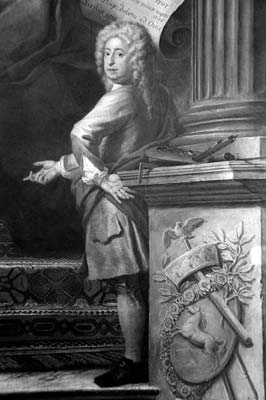
• Exit the hall, and cross the field to enter the...
Chapel of Sts. Peter and Paul: Not surprisingly, you’ll sense a nautical air in this fine chapel. Notice the rope motif in the floor tiles down the aisle. The painting above the altar, by American Benjamin West, depicts the shipwreck of St. Paul on the island of Malta. According to the Bible, Paul disturbed a poisonous viper but managed to throw it in a fire, miraculously without being harmed. Soon after the chapel was completed, it was gutted by a fire and had to be redecorated all over again. The plans were too ambitious, so the designers cut corners. Some of the columns and capitals are fake, and the “sculptures” lining the nave high above are actually trompe l’oeil—3-D paintings meant to look real. But some items, such as the marble frame around the main door, are finely crafted from expensive materials.
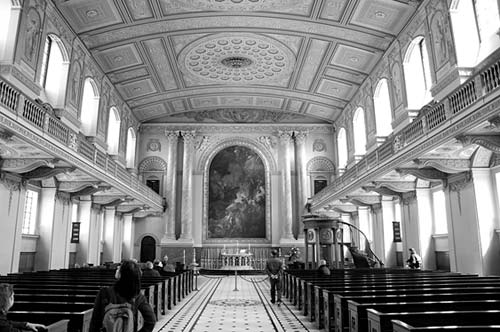
• Leave the chapel, and walk straight down to the water—enjoying the sweeping views across to the Docklands. When you hit the river, turn right for a quick...
Looking back toward the Old Royal Naval College, notice how it’s split into two parts; reportedly, Queen Mary didn’t want the view from the Queen’s House blocked. The college’s twin-domed towers (one giving the time, the other the direction of the wind) frame the Queen’s House, and the Royal Observatory Greenwich crowns the hill beyond.
Wander east along the Thames on Five Foot Walk (named for the width of the path). From here you can see the big, white, spiky O2 dome a mile downstream. This stadium languished for nearly a decade after its controversial construction and brief life as the Millennium Dome. Intended to be a world’s fair-type site and the center of London’s year 2000 celebration, it ended up as the topic of heated debates about cost overruns and its controversial looks. The site was finally bought by a developer a few years ago and rechristened “The O2” (a telecommunications company paid for the naming rights). Today it hosts sporting events and concerts. Next to the O2 are the towers of the Emirates Air Line cable car, which ferries passengers from the O2 across the Thames to, essentially, nowhere.
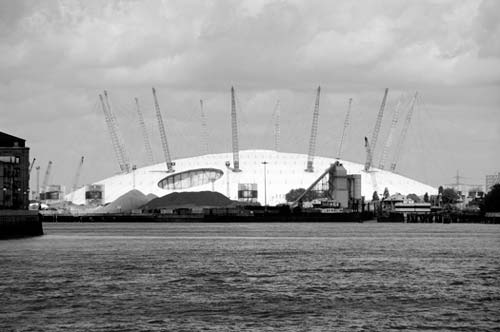
Continuing downstream, just outside the fenced college grounds, you’ll find the recommended Trafalgar Tavern. Dickens knew the pub well, and he used it as the setting for the wedding breakfast in Our Mutual Friend. Built in 1837 in the Regency style to attract Londoners downriver, the upstairs Nelson Room is still used for weddings. Its formal moldings and elegant windows with balconies over the Thames are a step back in time and worth a peek.
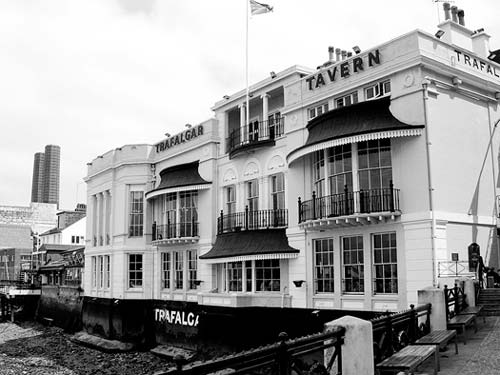
• From the Trafalgar Tavern, walk two long blocks up Park Row. After crossing busy Romney Road, turn right (through the gate near the corner) into the park. The palatial buildings in the middle of the park are the Queen’s House and the National Maritime Museum; the Royal Observatory Greenwich is on the hilltop beyond. This trio, paired with the Cutty Sark, form the Royal Museums of Greenwich.
In 1616 Inigo Jones designed the first Palladian-style villa in Britain for James I’s wife, Anne of Denmark. All traces of the queen are long gone, and the Great Hall and Royal Apartments now serve as an art gallery for the National Maritime Museum. Predictably, most of the art is nautical-themed, with plenty of paintings of ships and sea battles, and portraits of admirals and captains.
Cost and Hours: Closed for renovation; when open likely free and open daily 10:00-17:00—call or check website to confirm; tel. 020/8858-4422, www.rmg.co.uk .
• From the Queen’s House, walk toward the hill, pass through a colonnade, and turn right. About 300 yards farther on, you’ll see a giant ship in a bottle and the...
Great for anyone interested in the sea, this museum holds everything from a giant working paddlewheel to the uniform Admiral Horatio Nelson wore when he was killed at Trafalgar (look for the bullet hole, in the left shoulder). A big glass roof tops three levels of slick, modern, kid-friendly exhibits about all things seafaring.
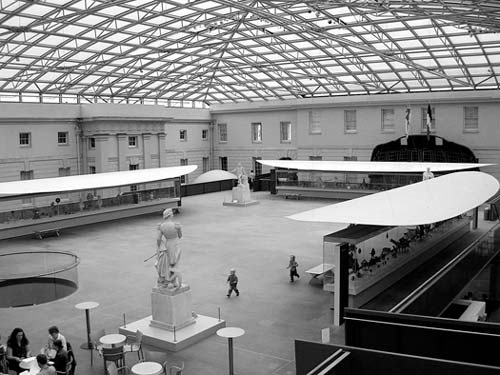
The Explorers exhibit covers early expeditions and an ill-fated Arctic trip, complete with a soundtrack of creaking wooden ships and crashing waves. One room displays stained-glass windows honoring members of London’s Baltic Exchange (an important shipping consortium) killed in World War I, while the somber Atlantic Worlds hall thoughtfully describes how the movements of goods, ideas, and enslaved people shaped the 17th to 19th centuries. Kids like the All Hands and Bridge galleries, where they can send secret messages by Morse code and operate a miniature dockside crane. Along with displays of lighthouse technology and a whaling cannon, you’ll see model ships, nautical paintings, and various salty odds and ends.
Cost and Hours: Free, daily 10:00-17:00, tel. 020/8858-4422, www.rmg.co.uk . The museum hosts frequent family-oriented events—singing, treasure hunts, and storytelling—particularly on weekends; ask at the desk. Inside, listen for announcements alerting visitors to free tours on various topics.
• The final sight in town—the Royal Observatory Greenwich—is at the top of the hill just behind the National Maritime Museum. To reach it, exit the Maritime Museum and follow signs leading you to a tree-lined uphill path, then follow the crowds as they huff up the steep hill (allow 10-15 minutes).
As you hike up, look along the observatory’s roof for the red Time Ball (also visible from the Thames), which drops daily at 13:00.
Located on the prime meridian (0° longitude), the observatory is famous as the point from which all time is measured. The observatory’s early work, however, had nothing to do with coordinating the world’s clocks to Greenwich Mean Time (GMT). The observatory was founded in 1675 by King Charles II for the purpose of improving navigation by more accurately charting the night sky. Today, the Greenwich time signal is linked with the BBC (which broadcasts the famous “pips” worldwide at the top of the hour). A visit here gives you a taste of the sciences of astronomy, timekeeping, and seafaring—and how they all meld together—along with great views over Greenwich and the distant London skyline. The Royal Observatory grounds are made up of the observatory (with the prime meridian and three worthy exhibits), the Weller Astronomy Galleries, and the Peter Harrison Planetarium.
If your only interest in the Royal Observatory is the famous prime meridian line, you can go through an unassuming iron gate just below the entrance for a free, more simplistic (and significantly less crowded) display of the prime meridian. Under the analog clock just outside the courtyard, see how your foot measures up to the foot where the public standards of length are cast in bronze.
Observatory: £9.50, includes audioguide, Day Explorer combo-ticket with Cutty Sark -£18.50, combo-ticket with planetarium-£12.50, saves money for either pair of sights; daily 10:00-17:00, until later in summer.
Weller Astronomy Galleries: Free, daily 10:00-17:00.
Peter Harrison Planetarium: £7.50, combo-ticket with observatory-£12.50; 30-minute shows generally run every hour (usually Mon-Fri 13:00-16:00, Sat-Sun 11:00-16:00, fewer in winter). Confirm times in advance by phone or online, or by picking up a flier at the observatory. As these shows can sell out, consider calling ahead to order tickets. Most shows are family-oriented, with early shows intended for young children.
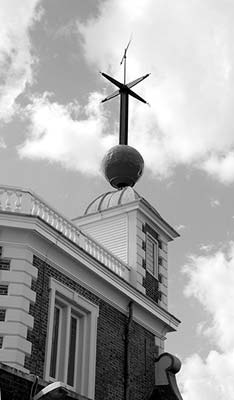
Information: Tel. 020/8858-4422, reservations tel. 020/8312-6608, www.rmg.co.uk .
 Self-Guided Tour:
At the top of the hill, you can buy tickets for the observatory or head to the Weller Astronomy Galleries. Since the observatory is more interesting, do that first (but note that the Weller Galleries won’t let you in after 16:30).
Self-Guided Tour:
At the top of the hill, you can buy tickets for the observatory or head to the Weller Astronomy Galleries. Since the observatory is more interesting, do that first (but note that the Weller Galleries won’t let you in after 16:30).
• After purchasing your ticket, enter the courtyard.
Running through the middle of this space is The Line—the prime meridian. Visitors wait patiently to have their photographs taken as they straddle the line in front of the monument, with one foot in each hemisphere. While watching all this fuss over a little line, consider that—unlike the equator—the placement of the prime meridian is totally arbitrary. It could just as well have been at my house, in Timbuktu, or even a few feet over—as, for a time, it was (the trough along the building’s roofline shows where one astronomer had placed it).
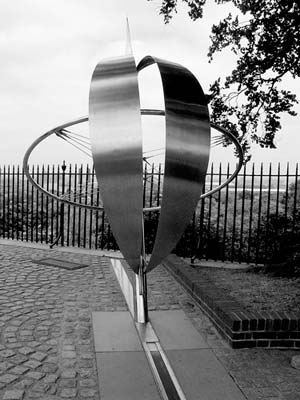
Three different attractions are scattered around this courtyard. First, hiding in a corner is a camera obscura. This thrillingly low-tech device projects a live image from Greenwich onto a flat disc in a darkened room simply by manipulating light, without electricity or machinery (although the image can be pretty dim on cloudy days). Imagine how astonishing it was in the days before television.
The smaller building is the Flamsteed House, named for John Flamsteed, the first king-appointed Astronomer Royal (in 1675). It contains the apartments that he lived in and the Wren-designed Octagon Room, where he carried out some of his work. Downstairs is a fascinating exhibit on the “Longitude Problem” and how it was solved (see sidebar). Also on display are all four of John Harrison’s sea clocks. Compared to his other contraptions, the fourth and final attempt looks like an oversized pocket watch. But, in terms of its impact, this little timepiece is right up there with the printing press, the cotton gin, the telegraph, and the money belt on the scale of human achievement.
The Meridian Observatory Building, in the larger house, has a wide assortment of historical telescopes, including a room-sized one designed by George Airy that was used to define the prime meridian. Watch the video (in the back corner of this room) of the telescope in action. If the meridian was too crowded outside, you can straddle it when you walk around this telescope. Upstairs from the gift shop, a skippable exhibit explores the role of timekeeping in our society.
• Now head out back.
Walk past the giant rusted-copper cone top of the planetarium. The building beyond houses the Weller Astronomy Galleries, where interactive, kid-pleasing displays allow you to guide a space mission and touch a 4.5-billion-year-old meteorite. You can also buy tickets for and enter the state-of-the-art, 120-seat Peter Harrison Planetarium from here.
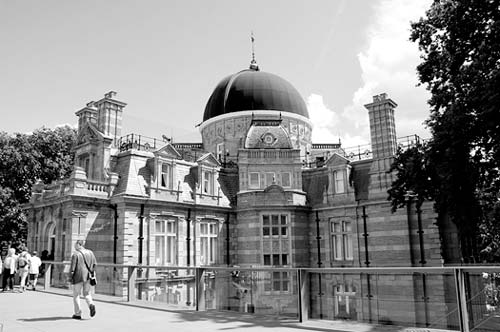
Before you leave the observatory grounds, enjoy the view from the overlook—the symmetrical royal buildings, the Thames, and the Docklands and its busy cranes (including the prominent Canary Wharf Tower, with its pyramid cap). You may be able to see—poking up between buildings—the white stadium and red Orbit tower in Queen Elizabeth Olympic Park. To the right is the huge O2 dome and the towers of the Emirates Air Line cable car. To the left lies the square-mile City of London, with skyscrapers and the dome of St. Paul’s Cathedral. The Shard is to the far left. At night (17:00-24:00), look for the green laser beam the observatory projects into the sky (best viewed in winter), which extends along the prime meridian for 15 miles.
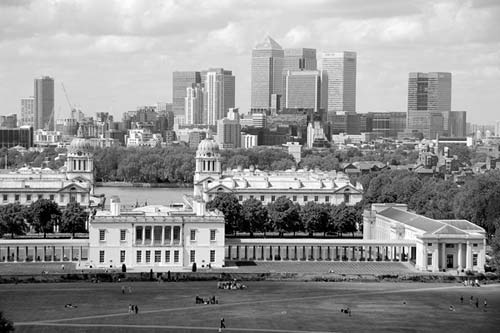
• Our tour through Greenwich is finished. Enjoy the views from this hilltop perch, then head back down The Avenue into town. The road becomes King William Walk and ends at the Cutty Sark and Greenwich Pier, where you can catch a boat or DLR train back to downtown London. If you have time, on your way back, remember that it’s easy to hop off the DLR for a quick visit to the Docklands; for details, see next page.